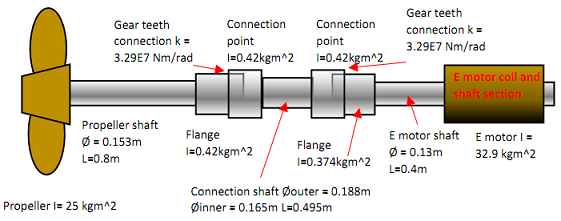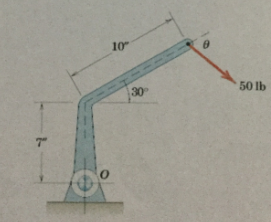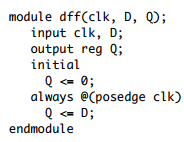Reference no: EM131101032
E15: Fundamentals of Digital Systems - Fall 2010 - HOMEWORK 6
1) In class we used some Boolean identities involving NAND to prove that sending an arbitrary value d to a D latch causes the latch to converge at the state Q=d, regardless of whether d is 0 or 1. In doing so we followed these rules:
- When a value changes, draw a box around it, and in the next row, re-compute all variables whose value depends on the changed variables.
- If no further changes in a row are possible, then the values have converged, and we place a check next to the row to show that the circuit has stabilized.
- Whenever we change an input variable, we copy down the previous values of the non-input variables into the row before determining whether their values change, on the next line.

Continue the table above by showing that if the D input changes to d' at t=30, that Q will converge to d'.
2) We will show using Boolean algebra that the positive edge triggered D flip-flop from the handout only changes Q to the value of D when the clock changes from 0 to 1. Starting with the initial inputs:

a. At t=10, change D to the value d, and show that Q remains the same.
b. At t=20, change Clk to 1, and show that Q takes on the value d.
c. At t=30, change d to d' and show that Q remains unaffected, but S and R both change back to 1.
3) We can construct state machines like the ones in Worksheet 6 by writing down a truth table for the state transition function. The inputs to the state transition function are the state variables Si, and the outputs are the "next state" variables Ni. From there, we can use K-maps to produce simplified Boolean expressions for each output, and then implement them using gates.
Produce diagrams for these state machines:
a. Using two D flip-flops and any additional gates necessary, construct a state machine that progresses from the state 00 to 01, 10, and finally to 11. Once in the state 11, your state machine should stay there indefinitely.
b. Using three D flip-flops and any additional gates necessary, construct a state machine that progresses through all of the three-bit Gray codes, starting with 000 and continuing through 100 before starting over.
4) Here is a module dff implementing a D flip-flop using behavioral Verilog*:

a. Construct a Verilog module hw6_4a(clk, S) that implements the first state machine above by instantiating two D flip-flops. Your module should take a single input (the clock), and it should assign its 2-bit output with the values of the flip-flops.
b. Similarly, construct a Verilog module named hw6_4b(clk, S) that implements the second state machine above by instantiating three D flip-flops.
Submit both of your Verilog modules to the Blackboard site in a zipfile. The archive should contain two files named hw6_4a.v, and hw6_4b.v.
|
What do we call an altered state of consciousness
: What do we call an altered state of consciousness, during which an individual has experiences different from those encountered during normal awake states or while dreaming?
|
|
What is the project npv
: The IRR of this 20-year project is 12.85%. If the firm's WACC is 11%, what is the project's NPV? Round your answer to the nearest cent. Do not round your intermediate calculations.
|
|
Company cost of common equity
: a. What is the company's cost of common equity if all of its equity comes from retained earnings? b. If the company were to issue new stock, it would incur a 10% flotation cost. What would the cost of equity from new stock be?
|
|
Determine the resulting bandwidth and time constant
: A non-inverting amplifier incorporates an op amp having an open-loop gain of 100 and bandwidth of 1 MHz. If the circuit is designed for a closed-loop gain of 16, determine the resulting bandwidth and time constant.
|
|
Writing down a truth table for the state transition function
: We can construct state machines like the ones in Worksheet 6 by writing down a truth table for the state transition function. The inputs to the state transition function are the state variables Si
|
|
What do we call the quality of ambiguity or disorientation
: What do we call the quality of ambiguity or disorientation that occurs in the middle stage of rituals, when participants no longer hold their pre-ritual status but have not yet begun the transition to the status they will hold when the ritual is ..
|
|
Firm average project
: Depreciation, salvage values, net operating working capital requirements, and tax effects are all included in these cash flows. Both projects have 4-year lives, and they have risk characteristics similar to the firm's average project. Bellinger's ..
|
|
Personal financial planning project
: This part of the personal financial planning project is where you put everything together. In this part you construct your personal financial plan. Specifically address the following required elements:
|
|
Investment in justus corporations stock
: You are considering an investment in Justus Corporation's stock, which is expected to pay a dividend of $1.75 a share at the end of the year (D1 = $1.75) and has a beta of 0.9. The risk-free rate is 4.0%, and the market risk premium is 4.0%. Justu..
|